Canon SX740 vs Ricoh WG-6
The Canon PowerShot SX740 HS and the Ricoh WG-6 are two digital cameras that were revealed to the public, respectively, in July 2018 and February 2019. Both the SX740 and the WG-6 are fixed lens compact cameras that are equipped with a 1/2.3-inch sensor. Both cameras offer a resolution of 20.2 megapixels.
Below is an overview of the main specs of the two cameras as a starting point for the comparison.

Check SX740 price at
amazon.com

Check WG-6 price at
amazon.com
Going beyond this snapshot of core features and characteristics, what are the differences between the Canon PowerShot SX740 HS and the Ricoh WG-6? Which one should you buy? Read on to find out how these two cameras compare with respect to their body size, their imaging sensors, their shooting features, their input-output connections, and their reception by expert reviewers.
Body comparison
The side-by-side display below illustrates the physical size and weight of the Canon SX740 and the Ricoh WG-6. The two cameras are presented according to their relative size. Three successive views from the front, the top, and the rear are shown. All width, height and depth dimensions are rounded to the nearest millimeter.
The SX740 can be obtained in two different colors (black, silver), while the WG-6 is also available in two color-versions, but different ones (black, orange).
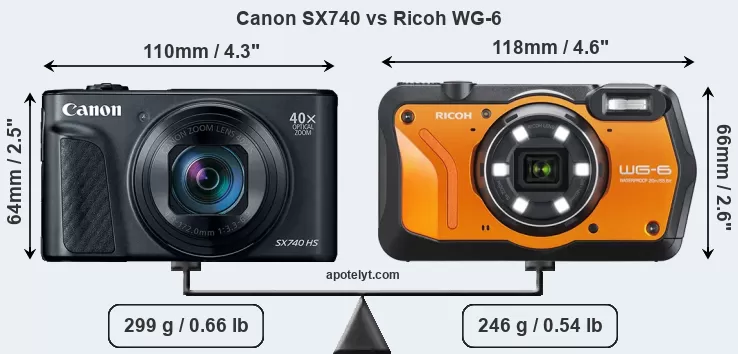
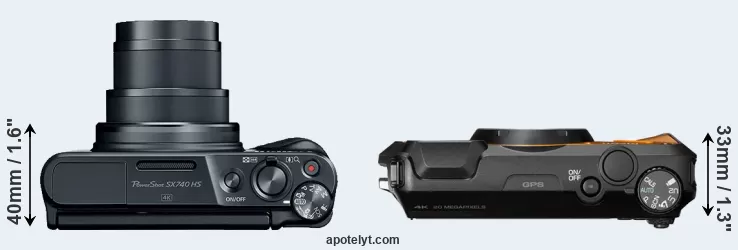
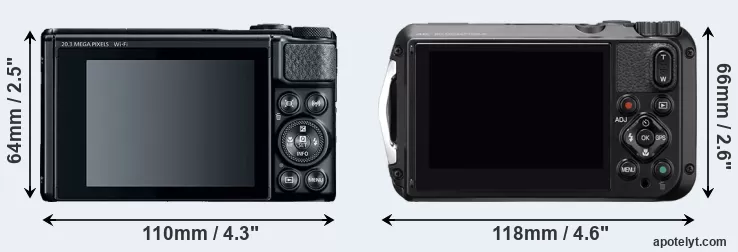
If the front view area (width x height) of the cameras is taken as an aggregate measure of their size, the Ricoh WG-6 is notably larger (11 percent) than the Canon SX740. However, the WG-6 is markedly lighter (18 percent) than the SX740. It is noteworthy in this context that the WG-6 is splash and dust-proof, while the SX740 does not feature any corresponding weather-sealing. More than that, the WG-6 is water-proof up to 20m and can, thus, be used for underwater photography.
Concerning battery life, the SX740 gets 265 shots out of its Canon NB-13L battery, while the WG-6 can take 340 images on a single charge of its Ricoh DB-110 power pack. The battery packs of both cameras can be charged via USB, which can be very convenient when travelling.
The following table provides a synthesis of the main physical specifications of the two cameras and other similar ones. If you would like to visualize and compare a different camera combination, you can navigate to the CAM-parator app and make your selection from a broad list of cameras there.

| Camera Model |
Camera Width |
Camera Height |
Camera Depth |
Camera Weight |
Battery Life |
Weather Sealing |
Camera Launch |
Launch Price (USD) |
Street Price |
||
|---|---|---|---|---|---|---|---|---|---|---|---|
| 1. | Canon SX740 | 110 mm | 64 mm | 40 mm | 299 g | 265 | n | Jul 2018 | 399 | amazon.com | |
| 2. | Ricoh WG-6 | 118 mm | 66 mm | 33 mm | 246 g | 340 | Y | Feb 2019 | 399 | amazon.com | |
| 3. | Canon SX70 | 127 mm | 91 mm | 117 mm | 608 g | 325 | n | Sep 2018 | 549 | amazon.com | |
| 4. | Canon SX430 | 104 mm | 69 mm | 85 mm | 323 g | 195 | n | Jan 2017 | 299 | ebay.com | |
| 5. | Canon SX710 | 113 mm | 66 mm | 35 mm | 269 g | 230 | n | Jan 2015 | 349 | ebay.com | |
| 6. | Canon SX720 | 110 mm | 64 mm | 36 mm | 270 g | 250 | n | Feb 2016 | 379 | ebay.com | |
| 7. | Canon SX730 | 110 mm | 64 mm | 40 mm | 300 g | 250 | n | Apr 2017 | 399 | ebay.com | |
| 8. | Panasonic TS7 | 117 mm | 76 mm | 37 mm | 319 g | 300 | Y | May 2018 | 449 | ebay.com | |
| 9. | Panasonic ZS70 | 112 mm | 67 mm | 41 mm | 322 g | 380 | n | Apr 2017 | 449 | ebay.com | |
| 10. | Panasonic ZS80 | 112 mm | 69 mm | 42 mm | 327 g | 380 | n | Feb 2019 | 449 | ebay.com | |
| 11. | Sony HX95 | 102 mm | 58 mm | 36 mm | 242 g | 370 | n | Aug 2018 | 429 | ebay.com | |
| 12. | Sony HX99 | 102 mm | 58 mm | 36 mm | 242 g | 370 | n | Aug 2018 | 449 | ebay.com | |
| 13. | Sony WX800 | 102 mm | 58 mm | 36 mm | 233 g | 370 | n | Oct 2018 | 399 | ebay.com | |
| Note: Measurements and pricing do not include easily detachable parts, such as add-on or interchangeable lenses or optional viewfinders. | |||||||||||
Any camera decision will naturally be influenced heavily by the price. The retail prices at the time of the camera’s release place the model in the market relative to other models in the producer’s line-up and the competition. The two cameras under review were launched at the same price and fall into the same market segment. Usually, retail prices stay at first close to the launch price, but after several months, discounts become available. Later in the product cycle and, in particular, when the replacement model is about to appear, further discounting and stock clearance sales often push the camera price considerably down.
Sensor comparison
The imaging sensor is at the core of digital cameras and its size is one of the main determining factors of image quality. A large sensor will generally have larger individual pixels that offer better low-light sensitivity, provide wider dynamic range, and have richer color-depth than smaller pixels in a sensor of the same technological generation. Furthermore, a large sensor camera will give the photographer more possibilities to use shallow depth-of-field in order to isolate a subject from the background. On the downside, larger sensors are more costly to manufacture and tend to lead to bigger and heavier cameras and lenses.
Both cameras under consideration feature a 1/2.3-inch sensor and have a format factor (sometimes also referred to as "crop factor") of 5.6. Within the spectrum of camera sensors, this places the review cameras among the smaller-sensor digicams that favor affordability and compact design. Both cameras feature a native aspect ratio (sensor width to sensor height) of 4:3.
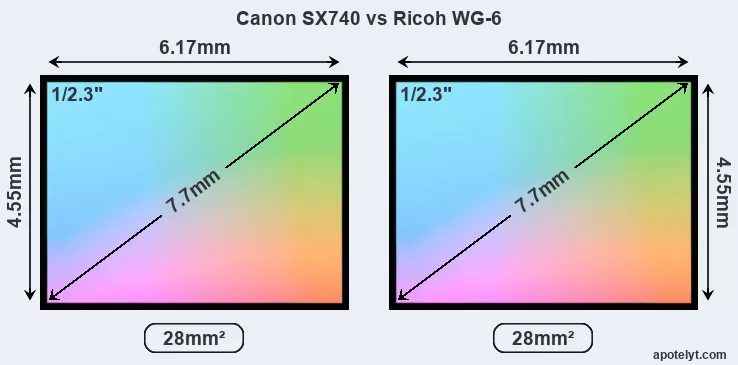
The two cameras under review do not only share the same sensor size, but also offer an identical resolution of 20.2 megapixels. This similarity in sensor specs implies that both the SX740 and the WG-6 have the same pixel density, as well as the same pixel size. It should, however, be noted that the WG-6 is a somewhat more recent model (by 6 months) than the SX740, and its sensor might have benefitted from technological advances during this time. Coming back to sensor resolution, it should be mentioned that neither of the two cameras has an anti-alias filter installed, so they are able to capture all the detail the sensor resolves.
The Canon PowerShot SX740 HS has a native sensitivity range from ISO 100 to ISO 3200. The corresponding ISO settings for the Ricoh WG-6 are ISO 125 to ISO 6400 (no boost).
Technology-wise, both cameras are equipped with BSI-CMOS (Backside Illuminated Complementary Metal–Oxide–Semiconductor) sensors. Both cameras use a Bayer filter for capturing RGB colors on a square grid of photosensors. This arrangement is found in most digital cameras.
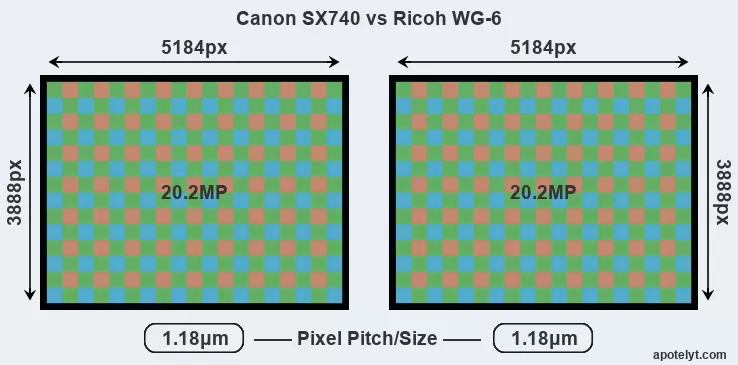
For many cameras, data on sensor performance has been reported by DXO Mark. This service assesses and scores the color depth ("DXO Portrait"), dynamic range ("DXO Landscape"), and low-light sensitivity ("DXO Sports") of camera sensors, and also publishes an overall camera score. The table below summarizes the physical sensor characteristics and sensor quality findings and compares them across a set of similar cameras.

| Camera Model |
Sensor Class |
Resolution (MP) |
Horiz. Pixels |
Vert. Pixels |
Video Format |
DXO Portrait |
DXO Landscape |
DXO Sports |
DXO Overall |
||
|---|---|---|---|---|---|---|---|---|---|---|---|
| 1. | Canon SX740 | 1/2.3 | 20.2 | 5184 | 3888 | 4K/30p | 20.6 | 12.1 | 1050 | 51 | |
| 2. | Ricoh WG-6 | 1/2.3 | 20.2 | 5184 | 3888 | 4K/30p | 20.7 | 12.2 | 1104 | 52 | |
| 3. | Canon SX70 | 1/2.3 | 20.2 | 5184 | 3888 | 4K/30p | 20.6 | 12.1 | 1063 | 51 | |
| 4. | Canon SX430 | 1/2.3 | 19.9 | 5152 | 3864 | 720/25p | 20.5 | 11.9 | 900 | 49 | |
| 5. | Canon SX710 | 1/2.3 | 20.2 | 5184 | 3888 | 1080/60p | 20.2 | 11.6 | 712 | 47 | |
| 6. | Canon SX720 | 1/2.3 | 20.2 | 5184 | 3888 | 1080/60p | 20.3 | 11.8 | 817 | 48 | |
| 7. | Canon SX730 | 1/2.3 | 20.2 | 5184 | 3888 | 1080/60p | 20.5 | 11.9 | 924 | 50 | |
| 8. | Panasonic TS7 | 1/2.3 | 20.2 | 5184 | 3888 | 4K/30p | 20.6 | 12.1 | 1028 | 51 | |
| 9. | Panasonic ZS70 | 1/2.3 | 20.2 | 5184 | 3888 | 4K/30p | 19.1 | 10.6 | 106 | 36 | |
| 10. | Panasonic ZS80 | 1/2.3 | 20.2 | 5184 | 3888 | 4K/30p | 20.7 | 12.2 | 1103 | 52 | |
| 11. | Sony HX95 | 1/2.3 | 18.0 | 4896 | 3672 | 4K/30p | 20.6 | 12.1 | 1057 | 51 | |
| 12. | Sony HX99 | 1/2.3 | 18.0 | 4896 | 3672 | 4K/30p | 20.6 | 12.1 | 1058 | 51 | |
| 13. | Sony WX800 | 1/2.3 | 18.0 | 4896 | 3672 | 4K/30p | 20.6 | 12.2 | 1070 | 51 | |
| Note: DXO values in italics represent estimates based on sensor size and age. | |||||||||||
Many modern cameras are not only capable of taking still images, but can also record movies. Both cameras under consideration have a sensor with sufficiently fast read-out times for moving pictures, and both provide the same movie specifications (4K/30p).
Feature comparison
Apart from body and sensor, cameras can and do differ across a variety of features. The SX740 and the WG-6 are similar in the sense that neither of the two has a viewfinder. The images are, thus, framed using live view on the rear LCD. The adjacent table lists some of the other core features of the Canon SX740 and Ricoh WG-6 along with similar information for a selection of comparators.

| Camera Model |
Viewfinder (Type or 000 dots) |
Control Panel (yes/no) |
LCD Specifications (inch/000 dots) |
LCD Attach- ment |
Touch Screen (yes/no) |
Max Shutter Speed * |
Max Shutter Flaps * |
Built-in Flash (yes/no) |
Built-in Image Stab |
||
|---|---|---|---|---|---|---|---|---|---|---|---|
| 1. | Canon SX740 | none | n | 3.0 / 922 | tilting | n | 1/3200s | 10.0/s | Y | Y | |
| 2. | Ricoh WG-6 | none | n | 3.0 / 1040 | fixed | n | 1/4000s | 1.0/s | Y | n | |
| 3. | Canon SX70 | 2360 | n | 3.0 / 922 | swivel | n | 1/2000s | 10.0/s | Y | Y | |
| 4. | Canon SX430 | none | n | 3.0 / 230 | fixed | n | 1/4000s | 0.5/s | Y | Y | |
| 5. | Canon SX710 | none | n | 3.0 / 922 | fixed | n | 1/3200s | 6.0/s | Y | Y | |
| 6. | Canon SX720 | none | n | 3.0 / 922 | fixed | n | 1/3200s | 5.9/s | Y | Y | |
| 7. | Canon SX730 | none | n | 3.0 / 922 | tilting | n | 1/3200s | 5.9/s | Y | Y | |
| 8. | Panasonic TS7 | 1170 | n | 3.0 / 1040 | fixed | n | 1/1300s | 10.0/s | Y | Y | |
| 9. | Panasonic ZS70 | 1166 | n | 3.0 / 1040 | tilting | Y | 1/2000s | 10.0/s | Y | Y | |
| 10. | Panasonic ZS80 | 2330 | n | 3.0 / 1040 | tilting | Y | 1/2000s | 10.0/s | Y | Y | |
| 11. | Sony HX95 | 638 | n | 3.0 / 922 | tilting | n | 1/2000s | 10.0/s | Y | Y | |
| 12. | Sony HX99 | 638 | n | 3.0 / 922 | tilting | Y | 1/2000s | 10.0/s | Y | Y | |
| 13. | Sony WX800 | none | n | 3.0 / 922 | tilting | Y | 1/2000s | 10.0/s | Y | Y | |
| Note: *) Information refers to the mechanical shutter, unless the camera only has an electronic one. | |||||||||||
The Canon SX740 and the Ricoh WG-6 both have an intervalometer built-in. This enables the photographer to capture time lapse sequences, such as flower blooming, a sunset or moon rise, without purchasing an external camera trigger and related software.
Both the SX740 and the WG-6 have zoom lenses built in. The SX740 has a 24-960mm f/3.3-6.9 optic and the WG-6 offers a 28-140mm f/3.5-5.5 (focal lengths in full frame equivalent terms). Hence, the Canon provides a wider angle of view at the short end, as well as more tele-photo reach at the long end than the Ricoh. The SX740 offers the faster maximum aperture.
Concerning the storage of imaging data, both the SX740 and the WG-6 write their files to SDXC cards. The SX740 supports UHS-I cards (Ultra High Speed data transfer of up to 104 MB/s), while the WG-6 cannot take advantage of Ultra High Speed SD cards.
Connectivity comparison
For some imaging applications, the extent to which a camera can communicate with its environment can be an important aspect in the camera decision process. The table below provides an overview of the connectivity of the Canon PowerShot SX740 HS and Ricoh WG-6 and, in particular, the interfaces the cameras (and selected comparators) provide for accessory control and data transfer.

| Camera Model |
Hotshoe Port |
Internal Mic / Speaker |
Microphone Port |
Headphone Port |
HDMI Port |
USB Port |
WiFi Support |
NFC Support |
Bluetooth Support |
||
|---|---|---|---|---|---|---|---|---|---|---|---|
| 1. | Canon SX740 | - | stereo / mono | - | - | micro | 2.0 | Y | - | Y | |
| 2. | Ricoh WG-6 | - | mono / mono | - | - | micro | 3.0 | - | - | - | |
| 3. | Canon SX70 | - | stereo / mono | Y | - | micro | 2.0 | Y | - | Y | |
| 4. | Canon SX430 | - | mono / mono | - | - | - | 2.0 | Y | Y | - | |
| 5. | Canon SX710 | - | stereo / mono | - | - | micro | 2.0 | Y | Y | - | |
| 6. | Canon SX720 | - | stereo / mono | - | - | micro | 2.0 | Y | Y | - | |
| 7. | Canon SX730 | - | stereo / mono | - | - | micro | 2.0 | Y | Y | Y | |
| 8. | Panasonic TS7 | - | stereo / mono | - | - | micro | 2.0 | Y | - | - | |
| 9. | Panasonic ZS70 | - | stereo / mono | - | - | micro | 2.0 | Y | - | - | |
| 10. | Panasonic ZS80 | - | stereo / mono | - | - | micro | 2.0 | Y | - | Y | |
| 11. | Sony HX95 | - | stereo / mono | - | - | micro | 2.0 | Y | Y | Y | |
| 12. | Sony HX99 | - | stereo / mono | - | - | micro | 2.0 | Y | Y | Y | |
| 13. | Sony WX800 | - | stereo / mono | - | - | micro | 2.0 | Y | Y | - |
It is notable that the SX740 offers wifi support, while the WG-6 does not. Wifi can be a very convenient means to transfer image data to an off-camera location.
Travel and landscape photographers will find it useful that the WG-6 has an internal geolocalization sensor and can record GPS coordinates in its EXIF data.
Both the SX740 and the WG-6 are recent models that are part of the current product line-up. The SX740 replaced the earlier Canon SX730 HS, while the WG-6 followed on from the Ricoh WG-5. Further information on the features and operation of the SX740 and WG-6 can be found, respectively, in the Canon SX740 Manual (free pdf) or the online Ricoh WG-6 Manual.
Review summary
So what is the bottom line? Is the Canon SX740 better than the Ricoh WG-6 or vice versa? A synthesis of the relative strong points of each of the models is listed below.

Arguments in favor of the Canon PowerShot SX740 HS:
- More flexible LCD: Has a tilting screen for odd-angle shots in landscape orientation.
- More selfie-friendly: Has an articulated screen that can be turned to be front-facing.
- Faster burst: Shoots at higher frequency (10 vs 1 flaps/sec) to capture the decisive moment.
- Better light gathering: Has a lens with a wider maximum aperture (f/3.3 vs f/3.5).
- Wider view: Has a wider-angle lens that facilitates landscape or interior shots.
- More tele-reach: Has a longer tele-lens for perspective compression and subject magnification.
- Sharper images: Has hand-shake reducing image stabilization built-in.
- Easier file upload: Has wifi built in for automatic backup or image transfer to the web.
- Easier wireless transfer: Supports Bluetooth for image sharing without cables.
- Faster buffer clearing: Has an SD card interface that supports the UHS-I standard.
- More heavily discounted: Has been on the market for longer (launched in July 2018).

Advantages of the Ricoh WG-6:
- More detailed LCD: Has a higher resolution rear screen (1040k vs 922k dots).
- Faster shutter: Has higher mechanical shutter speed (1/4000s vs 1/3200s) to freeze action.
- Less heavy: Has a lower weight (by 53g or 18 percent) and is thus easier to take along.
- Longer lasting: Gets more shots (340 versus 265) out of a single battery charge.
- Better sealing: Is splash and dust sealed for shooting in inclement weather conditions.
- Water-proof: Is rugged and sealed and can thus be used for underwater photography (up to 20m).
- Easier geotagging: Features an internal GPS sensor to log localization data.
- Faster data transfer: Supports a more advanced USB protocol (3.0 vs 2.0).
- More modern: Was introduced somewhat (6 months) more recently.
If the count of relative strengths (bullet points above) is taken as a measure, the SX740 emerges as the winner of the contest (11 : 9 points). However, the relevance of individual strengths will vary across photographers, so that you might want to apply your own weighing scheme to the summary points when reflecting and deciding on a new camera. A professional wildlife photographer will view the differences between cameras in a way that diverges from the perspective of a family photog, and a person interested in architecture has distinct needs from a sports shooter. Hence, the decision which camera is best and worth buying is often a very personal one.
How about other alternatives? Do the specifications of the Canon SX740 and the Ricoh WG-6 place the cameras among the top in their class? Find out in the latest Best Superzoom Camera and Best Travel-Zoom Camera listings whether the two cameras rank among the cream of the crop.
In any case, while the comparison of technical specifications can provide a useful overview of the capabilities of different cameras, it remains incomplete and does no justice, for example, to the way the SX740 or the WG-6 perform in practice. At times, user reviews, such as those published at amazon, address these issues in a useful manner, but such feedback is on many occasions incomplete, inconsistent, and unreliable.
Expert reviews
This is why hands-on reviews by experts are important. The adjacent summary-table relays the overall verdicts of several of the most popular camera review sites (amateurphotographer [AP], cameralabs [CL], digitalcameraworld [DCW], dpreview [DPR], ephotozine [EPZ], photographyblog [PB]). As can be seen, the professional reviewers agree in many cases on the quality of different cameras, but sometimes their assessments diverge, reinforcing the earlier point that a camera decision is often a very personal choice.

| Camera Model |
AP score |
CL score |
DCW score |
DPR score |
EPZ score |
PB score |
Camera Launch |
Launch Price (USD) |
Street Price |
||
|---|---|---|---|---|---|---|---|---|---|---|---|
| 1. | Canon SX740 | .. | + | 3.5/5 | .. | 4/5 | 4/5 | Jul 2018 | 399 | amazon.com | |
| 2. | Ricoh WG-6 | .. | .. | .. | .. | 3.5/5 | 3.5/5 | Feb 2019 | 399 | amazon.com | |
| 3. | Canon SX70 | .. | + + | 3.5/5 | .. | 3.5/5 | 3.5/5 | Sep 2018 | 549 | amazon.com | |
| 4. | Canon SX430 | .. | .. | .. | .. | 3.5/5 | 3.5/5 | Jan 2017 | 299 | ebay.com | |
| 5. | Canon SX710 | .. | + | .. | .. | 4/5 | 3.5/5 | Jan 2015 | 349 | ebay.com | |
| 6. | Canon SX720 | .. | + | .. | .. | 4/5 | 4.5/5 | Feb 2016 | 379 | ebay.com | |
| 7. | Canon SX730 | .. | + | .. | .. | 4/5 | 4/5 | Apr 2017 | 399 | ebay.com | |
| 8. | Panasonic TS7 | .. | + | .. | .. | .. | 3.5/5 | May 2018 | 449 | ebay.com | |
| 9. | Panasonic ZS70 | .. | + + | .. | .. | 4/5 | 4/5 | Apr 2017 | 449 | ebay.com | |
| 10. | Panasonic ZS80 | .. | + + | .. | .. | 4.5/5 | .. | Feb 2019 | 449 | ebay.com | |
| 11. | Sony HX95 | .. | .. | .. | .. | .. | .. | Aug 2018 | 429 | ebay.com | |
| 12. | Sony HX99 | .. | .. | .. | .. | 4/5 | 4.5/5 | Aug 2018 | 449 | ebay.com | |
| 13. | Sony WX800 | .. | .. | .. | .. | .. | .. | Oct 2018 | 399 | ebay.com | |
| Note: (+ +) highly recommended; (+) recommended; (o) reviewed; (..) not available. | |||||||||||
The review scores listed above should be treated with care, though. The assessments were made in relation to similar cameras of the same technological generation. A score, therefore, has to be seen in close connection to the price and market introduction time of the camera, and comparisons of ratings among very different cameras or across long time periods have little meaning. It should also be noted that some of the review sites have over time altered the way they render their verdicts.

Check SX740 price at
amazon.com

Check WG-6 price at
amazon.com
Other camera comparisons
Did this review help to inform your camera decision process? In case you are interested in seeing how other cameras pair up, just make your choice using the following search menu. Alternatively, you can follow any of the listed hyperlinks for comparisons that others found interesting.
- Canon 1D X Mark III vs Canon SX740
- Canon 20D vs Ricoh WG-6
- Canon 5D Mark II vs Canon SX740
- Canon R6 Mark II vs Canon SX740
- Canon SX740 vs Leica V-LUX 3
- Canon SX740 vs Nikon B700
- Canon SX740 vs Nikon D300
- Fujifilm X-A10 vs Ricoh WG-6
- Nikon D7000 vs Ricoh WG-6
- Olympus E-PM1 vs Ricoh WG-6
- Pentax 645Z vs Ricoh WG-6
- Ricoh WG-6 vs Sony A9
Specifications: Canon SX740 vs Ricoh WG-6
Below is a side-by-side comparison of the specs of the two cameras to facilitate a quick review of their differences and common features.
| Camera Model | Canon SX740 | Ricoh WG-6 |
|---|---|---|
| Camera Type | Fixed lens compact camera | Fixed lens compact camera |
| Camera Lens | 24-960mm f/3.3-6.9 | 28-140mm f/3.5-5.5 |
| Launch Date | July 2018 | February 2019 |
| Launch Price | USD 399 | USD 399 |
| Sensor Specs | Canon SX740 | Ricoh WG-6 |
| Sensor Technology | BSI-CMOS | BSI-CMOS |
| Sensor Format | 1/2.3" Sensor | 1/2.3" Sensor |
| Sensor Size | 6.17 x 4.55 mm | 6.17 x 4.55 mm |
| Sensor Area | 28.0735 mm2 | 28.0735 mm2 |
| Sensor Diagonal | 7.7 mm | 7.7 mm |
| Crop Factor | 5.6x | 5.6x |
| Sensor Resolution | 20.2 Megapixels | 20.2 Megapixels |
| Image Resolution | 5184 x 3888 pixels | 5184 x 3888 pixels |
| Pixel Pitch | 1.18 μm | 1.18 μm |
| Pixel Density | 71.80 MP/cm2 | 71.80 MP/cm2 |
| Moiré control | no AA filter | no AA filter |
| Movie Capability | 4K/30p Video | 4K/30p Video |
| ISO Setting | 100 - 3,200 ISO | 125 - 6,400 ISO |
| Screen Specs | Canon SX740 | Ricoh WG-6 |
| Viewfinder Type | no viewfinder | no viewfinder |
| LCD Framing | Live View | Live View |
| Rear LCD Size | 3.0inch | 3.0inch |
| LCD Resolution | 922k dots | 1040k dots |
| LCD Attachment | Tilting screen | Fixed screen |
| Shooting Specs | Canon SX740 | Ricoh WG-6 |
| Focus System | Contrast-detect AF | Contrast-detect AF |
| Continuous Shooting | 10 shutter flaps/s | 1 shutter flaps/s |
| Time-Lapse Photography | Intervalometer built-in | Intervalometer built-in |
| Fill Flash | Built-in Flash | Built-in Flash |
| Storage Medium | SDXC cards | SDXC cards |
| Single or Dual Card Slots | Single card slot | Single card slot |
| UHS card support | UHS-I | no |
| Connectivity Specs | Canon SX740 | Ricoh WG-6 |
| External Flash | no Hotshoe | no Hotshoe |
| USB Connector | USB 2.0 | USB 3.0 |
| HDMI Port | micro HDMI | micro HDMI |
| Wifi Support | Wifi built-in | no Wifi |
| Bluetooth Support | Bluetooth built-in | no Bluetooth |
| Geotagging | no internal GPS | GPS built-in |
| Body Specs | Canon SX740 | Ricoh WG-6 |
| Environmental Sealing | not weather sealed | Waterproof body (20m) |
| Battery Type | Canon NB-13L | Ricoh DB-110 |
| Battery Life (CIPA) | 265 shots per charge | 340 shots per charge |
| In-Camera Charging | USB charging | USB charging |
| Body Dimensions |
110 x 64 x 40 mm (4.3 x 2.5 x 1.6 in) |
118 x 66 x 33 mm (4.6 x 2.6 x 1.3 in) |
| Camera Weight | 299 g (10.5 oz) | 246 g (8.7 oz) |

Check SX740 price at
amazon.com

Check WG-6 price at
amazon.com
Did you notice an error on this page? If so, please get in touch, so that we can correct the information.

